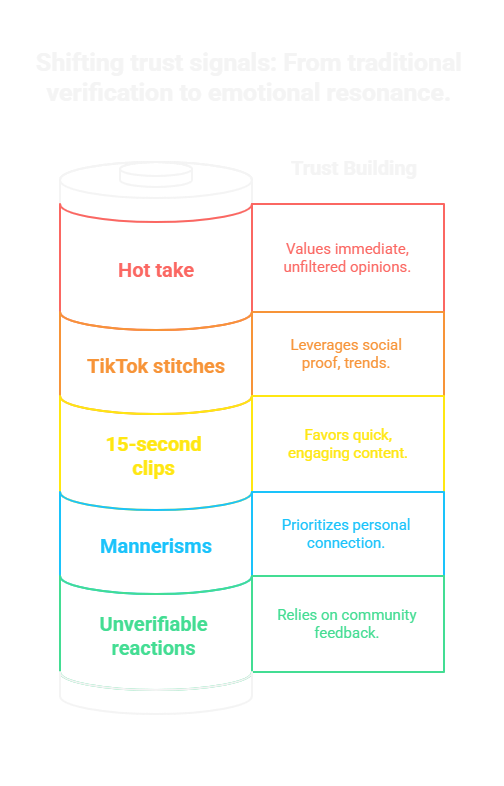The TikTokification of Trust: How Shortform Shapes Buyer Belief
Trust is no longer earned, it’s performed. Explore how shortform content turns emotional signals into purchase decisions, and what we lose in the process.
The TikTokification of Trust: Shortform, High-Volume, Low-Fidelity Signals
Swipe.
Pause.
She smiles.
You buy.
Not because she showed her credentials.
Not because the product is third-party verified.
But because the lighting was warm, the tone was familiar, and it all felt real.
This is the TikTokification of trust; a seismic shift from high-fidelity assurance to low-bandwidth emotional signals.
Trust Signals in the Age of Shortform
We used to earn trust through process:
Credentials
Reviews
Documentation
Proof-of-work
Now? Trust is performed, in seconds, through:
A raised eyebrow
A casual “I love this so much omg”
A stitched reaction to a viral comment
A sixty-second GRWM clip in a messy bathroom
And we respond, not with critical thinking, but with click-through confidence.
The trust loop has been compressed into a feeling.
Not an analysis.
Powering the Transition from Fidelity to Feeling
Let’s map this transformation:
This isn’t just a change in platform.
It’s a change in cognitive trust strategy.
Buyers now feel their way through the process, not navigate it.
The Volume Trap: More Signals, Less Signal
When everyone can perform authenticity, authenticity becomes noise.
We’re left parsing:
Who’s genuine vs. good at faking genuine?
Who believes what they’re selling vs. selling what converts?
Who is real, and does it even matter?
Because the truth is, in a TikTokified attention economy:
The signal isn’t “Do I trust this?”
It’s “Do I trust this enough to keep scrolling or buy before I forget it?”
Shortform commerce thrives on unconscious micro-decisions:
Buy it before your brain has time to vet it.
Watch it before you question it.
Swipe past before doubt forms.
Can Fleeting Trust Be Dependable?
Let’s ask the hard question:
Is it possible to build real, dependable trust in 15 seconds?
Or more critically:
What do we lose when trust becomes disposable?
Brand loyalty fades—you bought from the moment, not the company.
Consumer protection weakens—you don’t vet your emotional impulse.
Accountability vanishes—when trust is ambient, betrayal becomes invisible.
And worst of all:
Fraud becomes indistinguishable from charm.
What’s Left When the Signal Fails?
When a shortform creator disappears, gets exposed, or goes silent, there’s often no fallback:
No product history
No receipts
No chain of accountability
Just a broken vibe and a ghosted trust transaction.
Toward a Trust Recalibration
This isn’t a call to abandon short-form platforms.
It’s a call to rebuild the infrastructure around them:
Verified overlays for product links
Creator trust scores based on track record, not reach
Trust signal tagging: "first-time promote," "long-term user," "sponsored clarity"
And most importantly, slowing down the trust loop just long enough to think.
Because if trust is built in the blink of a scroll, it can dissolve even faster.
Coming Next:
“Trust by Design: Why UX is a Moral Act” — why every interface, button, and delay timer is an ethical decision with trust implications.



